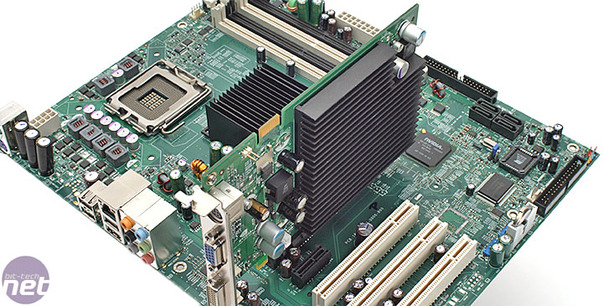Cooling
The CPU socket has a lot of room around it, although it is close to the top of the board. Thus, if your case's PSU is right above the motherboard a large cooler might only fit in a certain orientation.With something like the Noctua NH-U12F installed, and PSU that has a 120+mm fan in the bottom might work perfectly in tandem, perhaps with a shroud modded in to direct the airflow through one into the other? That could cut out an extra fan from your system and guarantees your hot CPU air is exhausted out the rear of the case.
The northbridge is passively cooled by quite a large 50x45x30mm heatsink, which is great for retaining a quiet case, however when running the heatsink feels like it has the fire of a thousand suns beneath it. We recorded a finger melting 74°C when running without any extra airflow, then we angled the CPU cooler to push air directly over it and it managed to drop the temperature by over 20°C to just 52°C.
Ideally you'd have some case airflow or an additional fan to keep it a touch cooler, but we haven't had a problem with stability the entire time during testing, which was completed without any additional airflow over the northbridge heatsink.
The southbridge on the other hand is entirely void of any cooling and gets only warm to touch, hovering at around 45°C. The motherboard includes holes for those who feel the need to add something on it. No additional cooling is applied to the power regulation components though, but there are motherboard holes supplied again if you fancy modding some yourself.

Power sockets, connectivity and pin outs
Both 24-pin ATX and 8-pin 12V sockets are placed right at the edges of the board for easy access, and due to its non-SLI nature the additional Molex socket has been left out. There are plenty (five) of fan sockets placed around the board from top to bottom, although one of the two just behind the rear I/O could do with being the other side of the board.The IDE port is placed right at the edge near the SATA ports, and the floppy port is along the bottom. Both are black and devoid of differentiation apart from physical size. Differentiation is applied to the four (blue) USB pin-outs, (yellow) RS232 serial port pin-out and front panel pin-out though. All of which are placed right down at the bottom edge of the board to keep the cable mess along the bottom and to a minimum. Unfortunately the front panel audio pin-out also gets the standard black treatment on the inside edge of the board, however.
Sound
Sound is provided by the Realtek ALC885 audio codec, which features 7.1+2 channel High-Definition audio up to 32-bit/192KHz. It also includes content protection for Blu-ray and HD-DVD disk lossless audio playback with specific versions of WinDVD and PowerDVD. The ten DACs are analogue weighted and rated at 106dB dynamic range, with ADCs also analogue weighted at a 101dB dynamic range.The three stereo input ports support microphones with Acoustic Echo Cancellation (AEC), Beam Forming (BF), and Noise Suppression (NS) technologies simultaneously. Regardless of the fact that this is a mainstream board, you get a quality codec with content protection so you can play HD movies. This could provide for a cheap, quiet and fully capable HTPC.
There's only a couple of large capacitors included on the board to smooth out the power to the audio codec, however, unlike the Gigabyte board which used a dozen small solid state aluminium capacitors and had a very good result in our RightMark Audio analysis tests.

Ethernet
A single physical layer (PHY) Gigabit Ethernet socket is provided by a Marvell 88E1116-NNC1 controller, with the RJ45 socket on the rear I/O. No teaming from a second socket is present, and you can't enable teaming with an additional PCI/PCI-Express network card: it's exclusive to the nForce 680i range only.A single Gigabit Ethernet will suit a lot of people, but the inclusion of 54g WiFi would cover a greater potential market. Having said that, we can't forget that this is a mainstream board, and also can't forget that there are plenty of expansion options via the eight USB 2.0 ports and three PCI slots.
Nvidia 650i Ultra Optimisations
Nvidia has made something specific to its nForce 650i Ultra chipset that's unavailable on other models in the series. Acknowledging that mainstream motherboards will be likely paired with mainstream GPUs such as the GeForce 7300 GT and 7600 GS, it has interlinked an automatic overclocking feature within the GPU when it's used with an nForce 650i Ultra motherboard.While just two cards is a particularly limiting enticement, given the fact that the 8-series graphics cards have now landed and even many of the 7900-series cards are incredibly good value now, it's still a great idea with plenty of potential for those unwilling to drop a wad of Adam Smiths on a high-end motherboard for features like LinkBoost.

MSI MPG Velox 100R Chassis Review
October 14 2021 | 15:04









Want to comment? Please log in.